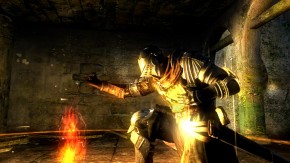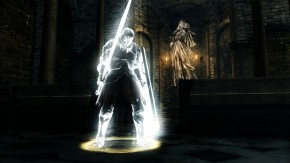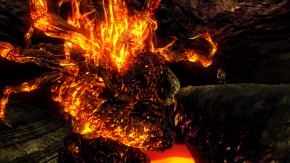Dark Souls


| Game Name: | Dark Souls |
| Platforms: | Playstation 3 (reviewed), Xbox 360 |
| Publisher(s): | Namco Bandai Games |
| Developer(s): | From Software |
| Genre(s): | Action-Adventure, Role-playing game |
| Release Date: | October 4, 2011 |
| ESRB Rating: | M |
| Big Ups: | Varied and beautiful locales, superb combat mechanics, immersive setting, great RPG elements, perfect character design |
| Big Downs: | Horrific framerate drops, occasional bugs |
I must start out by saying a couple things: I have completed Demon’s Souls; I did not find it as excruciatingly difficult as everyone else did; and I am needing to reflect upon my initial feelings of it to accurately review Dark Souls. This is because Dark Souls is EXACTLY like Demon’s Souls sans a hub world and the way the player obtains healing items. Don’t get me wrong however, this is in no way a bad thing. Dark Souls possesses all the great features that made Demon’s Souls amazing.
 For those of you that couldn’t muscle through the first couple hours of Demon’s Souls, death is the focal point of the game. This feature remains in Dark Souls. You can expect to die repeatedly and learn how to cope with it. This may be become quite an obstacle for seasoned gamers as death never serves any other function but failure in other games. It’s a punishing and grueling world where only the hard hearted survive. It’s grueling because of one factor, souls. Souls are the lifeblood of the game as they act as currency and experience. But while experience in most games is an abstract number, souls are material and have the potential of being lost through death. They are lost in an interesting manner, however. When the player dies, they have the opportunity to return to their place of death to recover a single blood stain where all of their currently lost souls have accumulated. The only problem is that the player must fight through all of the enemies they had slain in their past life all the way back to this blood stain. If they manage to get themselves killed in the process, that opportunity passes and the souls are lost forever. This is a harsh reality, but it gives the player a feeling of real accomplishment and justice when they finally manage to stumble wearily upon their hard earned souls.
For those of you that couldn’t muscle through the first couple hours of Demon’s Souls, death is the focal point of the game. This feature remains in Dark Souls. You can expect to die repeatedly and learn how to cope with it. This may be become quite an obstacle for seasoned gamers as death never serves any other function but failure in other games. It’s a punishing and grueling world where only the hard hearted survive. It’s grueling because of one factor, souls. Souls are the lifeblood of the game as they act as currency and experience. But while experience in most games is an abstract number, souls are material and have the potential of being lost through death. They are lost in an interesting manner, however. When the player dies, they have the opportunity to return to their place of death to recover a single blood stain where all of their currently lost souls have accumulated. The only problem is that the player must fight through all of the enemies they had slain in their past life all the way back to this blood stain. If they manage to get themselves killed in the process, that opportunity passes and the souls are lost forever. This is a harsh reality, but it gives the player a feeling of real accomplishment and justice when they finally manage to stumble wearily upon their hard earned souls.
The finely crafted control scheme permits for this rewarding sensation. The controls are basic but perfectly constructed so that the player can only look to themselves when something goes awry. Instead of most games, where the block button is part of the main action buttons, the left and right triggers control the character’s respective arms. This requires a slight learning curve, but instead of hindering the gameplay, it actually enhances it. Success solely bases itself on how skillfully the player can maneuver their character and their choice of what to gear their character with. So if the player decides to ditch a shield for a flashy pair of dual-wielded swords, they will not have the effective means to block. This being said, yes, it is possible to dual-wield shields; however, both cannot block as one hand will always act as the attacking hand.
 So here the player has all of the tools to survive and that’s what they must do. At the beginning of the game, the game gives the player a choice of ten different classes ranging from warrior to thief to wizard to caveman. Depending on what the player chooses, their starting equipment and base stats change. But this is where the fun fact comes into play, though it would be wise to build a warrior as a beefy tank or a wizard as an intelligent spell caster, the player can dump points wherever they desire to gain access to things only limited by stat restrictions. So the player can very possibly have a spell-casting knight or a battle mage. This is strictly at the player’s discretion but provides for a unique gaming experience every playthrough.
So here the player has all of the tools to survive and that’s what they must do. At the beginning of the game, the game gives the player a choice of ten different classes ranging from warrior to thief to wizard to caveman. Depending on what the player chooses, their starting equipment and base stats change. But this is where the fun fact comes into play, though it would be wise to build a warrior as a beefy tank or a wizard as an intelligent spell caster, the player can dump points wherever they desire to gain access to things only limited by stat restrictions. So the player can very possibly have a spell-casting knight or a battle mage. This is strictly at the player’s discretion but provides for a unique gaming experience every playthrough.
I find it difficult to describe Dark Souls, especially once I begin to delve into the actual world of Lordran. Though Demon’s Souls’ world lingered on the bizarre, Dark Souls’ world falls straight into the surreal. It could be due to the lack of lore or unexplained events, but when the player finally is cast out of the tutorial realm of the “Undead Asylum” thus begins a harrowing but tangible journey. Though things feel strange at first, there is a level of consistency to everything the player encounters. Not only that, the world is endless. It expands for what seems to be an eternity but there is no feeling of ultimately complete discovery. Even after overcoming the sensation of this overwhelming world, the player is introduced to a plethora of equally bizarre and unpredictable NPCs. Each and every one of these NPCs have their own personal agendas and lives which can never be predicted. There are times when an NPC will turn up in a completely different location from where the player found them and through a few select dialogue cues, they reveal their personal journey or personal philosophies on the world around them. This world never forces the player to feel obligated to a specific philosophy, so when the aspect of covenants comes into play, it never seems that the player is truly making a bad choice. So much so, fans debated which covenant fell into which of the nine standard RPG alignment types.
 Covenants are mostly used for PvP manipulation. It would take too long to describe each, but essentially all covenants have specific benefits and requirements of their members. If these requirements are not fulfilled, the player is forced out of the covenant and cannot rejoin until their “sins are absolved.” But the benefits provide drastically unique benefits that make the characters unique as well as have varied experiences. For example, one covenant provides you with a ring that teleports you to its “headquarters” when another player decides to enter the area without being part of the covenant. In another example, the guild provides you with an item that lets you willingly invade other people’s worlds whenever you like. Basically, these features are meant for PvP encounters but are nicely veiled in interesting story mechanics. Like I said, Dark Souls is a complicated world that feels never-ending. It is utterly fantastic considering, in this day and age, most developers feel the need to explain away every detail and severely limit their worlds with weak one-dimensional characters.
Covenants are mostly used for PvP manipulation. It would take too long to describe each, but essentially all covenants have specific benefits and requirements of their members. If these requirements are not fulfilled, the player is forced out of the covenant and cannot rejoin until their “sins are absolved.” But the benefits provide drastically unique benefits that make the characters unique as well as have varied experiences. For example, one covenant provides you with a ring that teleports you to its “headquarters” when another player decides to enter the area without being part of the covenant. In another example, the guild provides you with an item that lets you willingly invade other people’s worlds whenever you like. Basically, these features are meant for PvP encounters but are nicely veiled in interesting story mechanics. Like I said, Dark Souls is a complicated world that feels never-ending. It is utterly fantastic considering, in this day and age, most developers feel the need to explain away every detail and severely limit their worlds with weak one-dimensional characters.
The most fascinating experience of Dark Souls extends from its multiplayer. It is a unique feature only found in its predecessor where players do not have a separate title menu option to use it but instead are constantly offered opportunities to call on it to assist or entertain their endeavors. Interestingly, the life and death factor comes even further into play here as the body has two forms: human and hollow. If the player dies, regardless of which for he is in, he will revert into hollow form. This has some slight penalties but nothing too heavy to make things difficult. But as you play, you find things called humanities which allow the player to revert back to a human when offered at a bonfire. When in human form, the player is exposed to a number of multiplayer options. When in an area with an “end level” boss, the player can either lay down a sign to assist other players or touch others’ signs to bring in up to two other players to assist them until they defeat the boss. On the other hand, the player can choose to invade other players’ worlds to possibly gain souls and humanities from defeating them. Adversely, the player is just as at risk for being invaded. It’s a great experience to assault or defend against another player and succeed though.
 Visually, Dark Souls begins to falter. It’s strange though. From the third-person perspective, the game is gorgeous: environments are lush with color; locales never get dull; armor and weapons glisten as light bounces of their surfaces; and enemies possess extravagant visages. Disturbingly, all this beauty begins to break down when the camera manages to meander too close to a static object. Suddenly, textures look terrible and the smooth bump mapping vanishes. Not only that, at times, during what would seem to be an area of moderate visual activity, framerates plummet to terrible and even unbearable levels. Considering the aforementioned lack of visual advances, it’s mind-boggling to have framerate drops when a lot of the distant backgrounds are comprised of simple, low-res paintings and a majority of the enemies are low-poly models wrapped in low-res textures. But whatever, the game is still flipping amazing.
Visually, Dark Souls begins to falter. It’s strange though. From the third-person perspective, the game is gorgeous: environments are lush with color; locales never get dull; armor and weapons glisten as light bounces of their surfaces; and enemies possess extravagant visages. Disturbingly, all this beauty begins to break down when the camera manages to meander too close to a static object. Suddenly, textures look terrible and the smooth bump mapping vanishes. Not only that, at times, during what would seem to be an area of moderate visual activity, framerates plummet to terrible and even unbearable levels. Considering the aforementioned lack of visual advances, it’s mind-boggling to have framerate drops when a lot of the distant backgrounds are comprised of simple, low-res paintings and a majority of the enemies are low-poly models wrapped in low-res textures. But whatever, the game is still flipping amazing.
 This is exemplified by the superb sound design. The endless amount of audio cues is astonishing. With tons and tons of unique enemies with tons and tons of their own unique sounds, the game never fails to get dull. Music matches the world perfectly with the hauntingly mysterious to intense imminent death tracks. A majority of the game, however, is only accompanied by the sounds of the environment. It helps in making the player feel as if they really are alone in this strange and hostile world.
This is exemplified by the superb sound design. The endless amount of audio cues is astonishing. With tons and tons of unique enemies with tons and tons of their own unique sounds, the game never fails to get dull. Music matches the world perfectly with the hauntingly mysterious to intense imminent death tracks. A majority of the game, however, is only accompanied by the sounds of the environment. It helps in making the player feel as if they really are alone in this strange and hostile world.
As you can tell, I love Dark Souls. It is everything I could have ever dreamed of from an action-adventure game. Even tying into old timely dungeon crawlers, the game manages to beautifully incorporate tons of fascinatingly refreshing features. With the inclusion of a New Game+ feature and excessive amounts of indefinite plot development trees, this game could last you months. Games like these just raise my standards so high that it is certain I will be forever comparing every other future action-adventure game to this one. And if it doesn’t even glean the slightest bit of what Dark Souls provides, it will probably be marked as a waste of my time.







